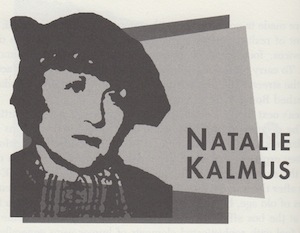
Born: January 20, 1892, Boston, MA
Died: November 15, 1965, Boston, MA
In her reign, Kalmus supervised and guided the intricate color process on some of the great classics.
—Ally Acker
Inventor Herbert T. Kalmus could never have guessed that his wife’s contribution to film history would surpass his own. After all, it was Herbert who created a color method for film. An MIT graduate in 1915, he saluted his alma mater, “Tech,” by patenting Technicolor, then waited for Hollywood to make him rich. But Hollywood took its time, and moviegoers sat through many dull experiments with color. Early innovators tried staining or hand-tinting film stock. This resulted in strange night scenes of complete blue, or kissing scenes covered in red. Color was inconsistent, its gradual development lacked the overnight impact of sound and talkies had proved they could succeed in black and white, so most movie studios had given color the pink slip.
Still, Natalie Kalmus wouldn’t let interest in color wane. She campaigned tirelessly for Technicolor, pitching studio heads and traveling abroad to educate foreign filmmakers. With all of her efforts, however, feature film studios remained reluctant to purchase the technology. Finally, Natalie came upon a better idea—after years of looking for buyers, she would start looking for renters. Essentially, Natalie Kalmus turned the process of Technicolor into a full-blown service.
Kalmus’s “package deal” was a complete crayon box for studios. Traditionally, color was used sparingly in films to save cost: the 1925 Ben-Hur used color only in biblical scenes. But Kalmus offered the equipment, cameramen and makeup, costume, set and prop designers, all for a flat rate. She leased to producers an entire team of Technicolor experts, and her laboratory was solely responsible for the final output.
An extreme perfectionist, Kalmus learned the business of making movies in the studio system and tailored her organization to fit the needs. She was part technician, part artist, part entrepreneur, and she studied the technical aspects of the process thoroughly. She became a master of color, understanding its place in dramatic composition and its power to affect emotions. Because Technicolor required intense light, she learned to counter the effects of reflected glare in certain colors by hand-picking fabrics, paints and makeup to achieve distinct contrast between neighboring hues. When her color needs couldn’t be met on the set, she had her staff develop special dyes to correct the problem in the lab. In many cases, she was involved with a film for as long as the director, being present from planning stage until the final prints were made.
Despite a year of delivering a distinct color signature on films like The Adventures of Robin Hood (1938) and The Wizard of Oz (1939), Kalmus was having trouble justifying the high costs of Technicolor. As 1939 approached, she feared color was on the block again. Gone with the Wind (1939) changed all that. Its brilliant use of color placed the film far ahead of the other outstanding films of that productive year. Studio executives then put Technicolor at the top of their wish list for the really big productions. Kalmus’s contribution to Gone with the Wind all but secured the future of color films.
Kalmus struck a seven-year sweetheart agreement with Walt Disney granting him exclusive use of Technicolor in animated films, making the process popular in animation departments. She also made trips abroad several times a year to help other film industries develop a Technicolor process. In 1948, she packed an entire crew and flew to England to train British crews extensively on appropriate use of color in costumes, makeup and set design. Her suggestions were right on the mark for Michael Powell’s The Red Shoes (1948) and the ballet melodrama became the exemplary Technicolor film.
Although Kalmus had several capable lieutenants, she tackled the toughest assignments herself. Director John Ford wasn’t much for consultants, but he carefully listened to Kalmus when he used Technicolor on She Wore a Yellow Ribbon (1949). She explained to Ford that many directors overused the process and didn’t take advantage of her ability to custom-manufacture special hues. Ford gave her great latitude, and Yellow Ribbon was truly a joint effort between the two, defining the look of the color western.
Kalmus enjoyed a monopoly for close to twenty-five years. Virtually every color film made between 1925 and 1950 (representing 12 percent of all Hollywood features over that time) was produced using Technicolor, and Natalie insisted that her name be credited as color consultant on every one. Throughout the forties, she made $65,000 annually. When the Kalmus patent expired in 1949, the Eastman Kodak Company was ready to dethrone Queen Natalie and introduced a rival process. By 1952, the studios no longer needed Technicolor’s specialized equipment and expensive consultants. The vogue for wide-screen and 3-D movies, which couldn’t be produced with Technicolor cameras, hastened the demise. Even studios who used the process to make their original master prints could no longer afford the expense of Technicolor, so when it came time to make duplicate prints, many Technicolor classics were sent out in a cheaper two-color process.
Natalie Kalmus saved color films from an early death, and her legacy remains—color films prevailed. By 1954, more than 50 percent of American features were made in color, and the figure reached 94 percent by 1970. Today, black-and-white films cost more to make than color films. Her Technicolor company is still in business, using a different, more economical procedure to get color results. Preservationists like director Martin Scorsese are championing the return of the process, which they find superior in quality and best for longevity.
To read all the republished articles from ‘The Film 100,’ go to Reintroducing the Film 100 here on Keyframe.




